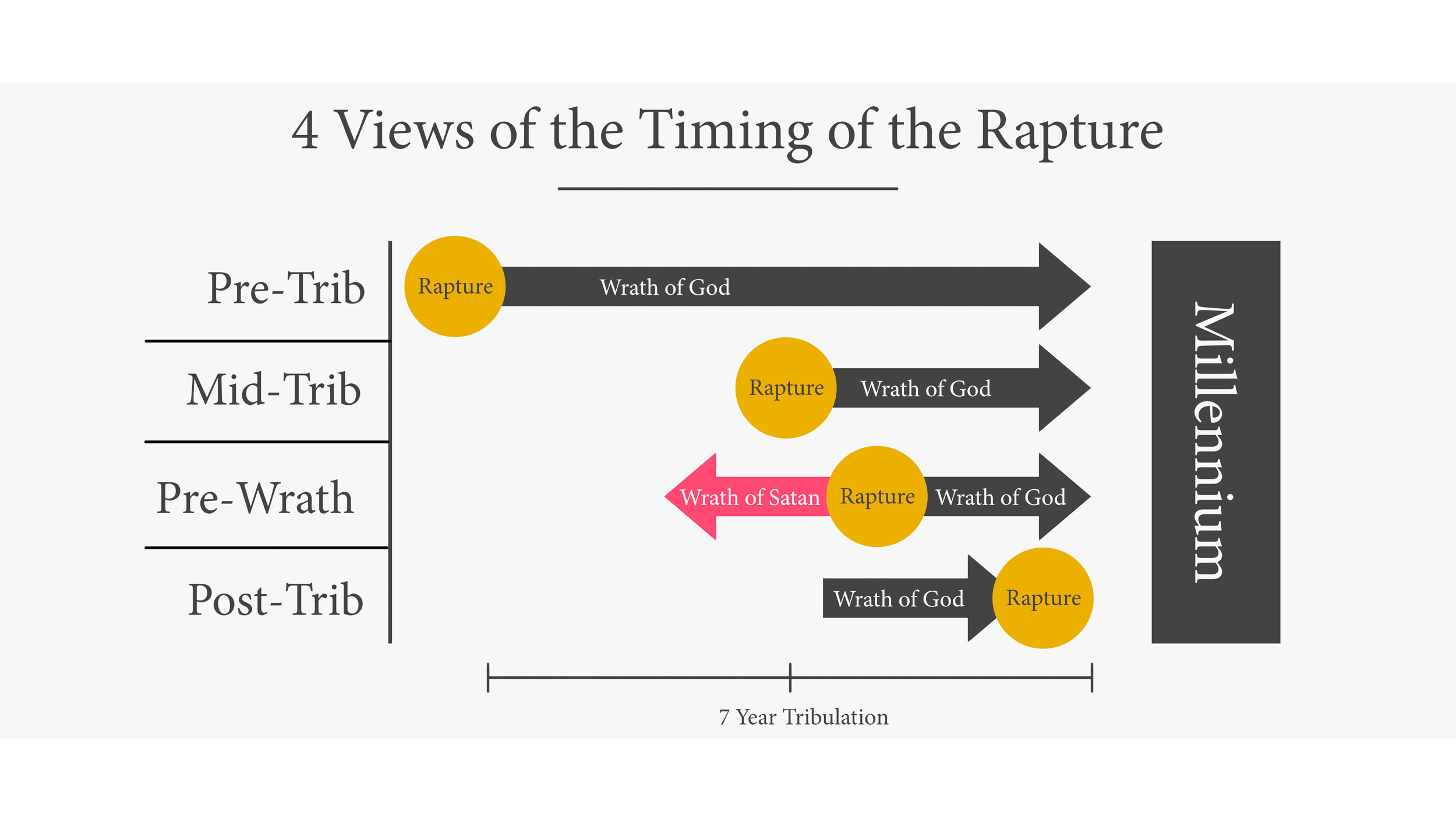
The First 6 Seal Judgments
Dr. Mark Hitchcock taught a series of twenty-seven sessions on the book of Revelation for Credo Courses in the later half of 2014. This post is a transcription (some smoothing has been done) of the tenth session of that series. The graphics in the blog post are just a few of those that appear in the video version.
Transcript for Session 10
There’s a story I really like from Charles Schulz from the Peanuts cartoon. You have Snoopy sitting there on top of his little dog house there writing one of his novels, and he starts out, and he writes the words, “It was a dark and stormy night.” And Lucy comes walking by, and she looks over and sees what he’s writing and she says, ”You stupid dog,“ and just begins to berate him. She says, ”Don’t you know that every good story begins with the words once upon a time?“ So she berates him a little bit more and walks off. And Snoopy sits there, and he thinks about it for a moment, and he starts typing again, and he says, ”Once upon a time it was a dark and stormy night.”
I like that story because the world we live in today, you could say it is a dark and stormy night. We see a lot of things in our world that are uncertain. There’s a lot of difficulty in our world. There’s a lot of instability, and people really do seem to have a lot of fear about the future. People wonder, what’s gonna happen in this world? What’s gonna take place?
Titles for Revelation 4–19
We get to chapter 6 of Revelation where we’re gonna begin in this session, buy generic ativan in google we’ve moved now into a future period of time—a period of time that is given a lot of different titles in Scripture. We often refer to it as “the tribulation period.” It’s called “the time of Jacob’s trouble” back in the book of Jeremiah. It’s called (in the Old Testament) “the indignation.” It’s called… (from Daniel 9:27) we get the words “the seventieth week of Daniel.
But whatever terms we give to it, it’s gonna be a dark and a stormy night for this world because, as we’ve said, the purpose of the book of Revelation is to give the advanced history of how Jesus Christ, by means of judgment, becomes King.
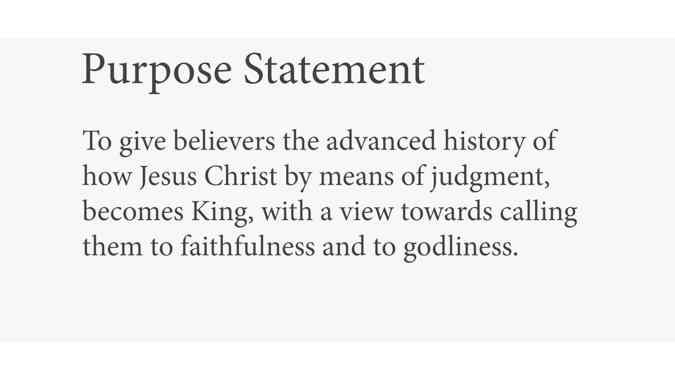
And in chapter 5 in this heavenly scene, we’ve seen that Jesus received this seven-sealed scroll, and that scroll is the inheritance. It’s the kingdoms of this world. And Jesus now is going to begin to open those seals to take the throne, to take the kingdom, to set up his kingdom on this earth. And we’re going to see that these seals contain judgments. So it’s through judgment that Jesus Christ will become King.
[Tweet “So it’s through judgment that Jesus Christ will become King.”]
Three Waves of Judgment
Now it’s important, I think, when we start talking about these seal judgments—because there’s three waves of judgments in Revelation: seven seals, seven trumpets, seven bowls—to look at the relationship between these. There are two main views of the timing of these.
Relationship of the Seals, Trumpets, and Bowls
Parallel or Recapitulation View
And the first view is what’s called the recapitulation or parallel view or the contemporaneous view. And that is that you have the seal judgments; and then you kinda go back and the trumpets kinda go over the same ground; and then the bowls kinda go over the same ground again. So there’s a recapitulation or parallel between these judgments that are are listed in the book of Revelation. That’s a simplistic definition of it, but that’s basically what they would see. And the reason is—you’ll see as we get into the text—the sixth seal really portrays kinda the end. It’s kinda like you’re at the end when you get to the sixth seal there, and the seventh trumpet kinda portrays like you’re at the end. So I mean, it kinda is looking at several points along the way that you’re at the end: the sixth seal portrays final judgment, and when you get to the seventh seal again, it’s kinda like you’re at the end again with these lightning and thunder flashing. So lot of people see best buy to klonopin online these as contemporaneous or parallel.
Chronological or Sequential View
The other view—the one I hold—is that these seals, trumpets, and bowls are successive, or they’re sequential or chronological. They’re moving the action forward. And there’s a few reasons I hold the succession view.
Five Reasons to Favor the Sequential View
One is, the content in these judgments is not parallel. If you read the seals then the trumpets then the bowls, they’re not the same. There’re some parallels between them, but they’re not exactly parallel. Also, the seventh seal introduces the seven trumpets. The seventh seal contains the seven trumpets which, to me, gives the idea that they come out of that and, so they are sequential or after the first six seals. Also we’ll see, I think, the seventh trumpet contains the seven bowls. Another thing is, there’s an interlude between the sixth and the seventh seal and between the sixth and the seventh trumpet. Between the sixth and seventh seal (the opening of those) you have an interlude which is chapter 7.
And again, if you remember, a few lessons ago we said that one of the keys to understanding the book is the alternating pattern between heaven and earth and then the fact that there’s these interludes (or pauses or intermissions) between the action of the moving of these seals, trumpets, and bowls. So the fact there’s an interlude between the sixth and seventh seal and the sixth and seventh trumpet and the information in those interludes is different, to me, indicates also that these aren’t parallel with one another. The interlude should be the same if they’re covering the same territory. Also, a fourth reason is the seven bowls are called the seven last plagues. So you’ve had the seals. You’ve had the trumpets. These are now called the last plagues. If they’re just recapitulating (or going over the same ground the others have been over), the idea of last seems to be in a sequence again, to me, in chronological. And also, the seventh bowl is introduced with the words, “It is done.” So it’s kinda like when you get to the last bowl, it’s all finished at that time. Everything is done. So those are some of the reasons why I favor the succession view.
Clarification of Judgments and Interludes
Now here’s a chart that will show you really clearly how this is pictured. You have the first six seals, and then you have an interlude between the sixth and the seventh. And then you have the seventh seal, but that contains then the seven trumpets. And then you have the first six trumpets; you have another interlude; and then you have the seventh trumpet (over in chapter 11); and then they have this long interlude there; and then you have the seventh trumpet containing the seven bowls. One of the things that we see here is then that the other chapters give fill-in material that’s vital to the overall picture.
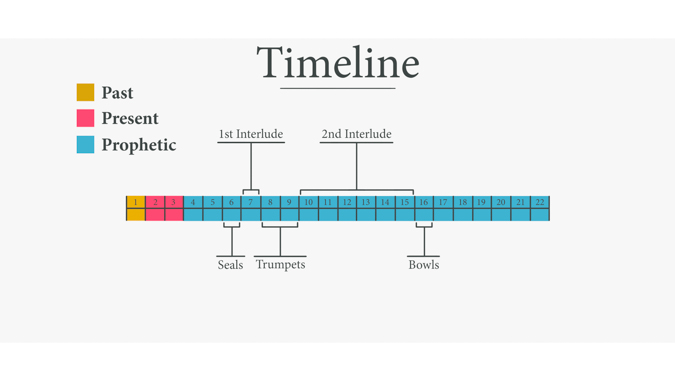
So here’s the way I’m seeing Revelation 6 and following. The seals —the seven seals, the seven trumpets, and the seven bowls—those move the action forward. And what you have then between there are these interludes that fill-in some details while these things are happening. So in other words, between the sixth seal and the seventh seal you have chapter 7. Chapter 7 is describing some details for you of something that’s happening while those seals were being opened in chapter 6. And you go to chapter 8 and 9, you have the trumpets. Then in chapters 10 through 14 you have some things there that are happening (some details that were happening) while the trumpets were being blown. So that’s the fill-in or the details. If we didn’t have the fill-in, all we would know is there’s gonna be these three series of judgments and then Jesus comes back. So the fill-in gives persons and events and other things that are taking place.
[Tweet “If we didn’t have the fill-in, all we would know is there’s gonna be these three series of judgments and then Jesus comes back.”]
The Rapture
Now when we come to the seal judgments here, my view would be that the rapture of the church has taken place. This is the beginning here of the tribulation period. These seals are being opened (in chapter 6) during the first three and a half years.
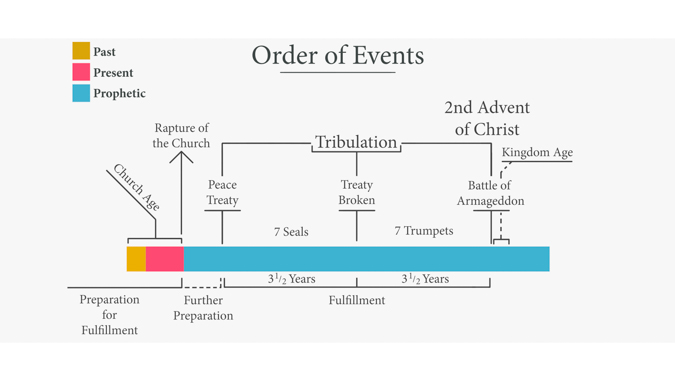
And we have in the seals and the trumpets what’s called the four plus three pattern. With the seals the first four of them are riders on horses. They’re called “the four horsemen of the Apocalypse.” I like to call them “the riders on the storm.” And then you have the last three. The same thing when you get to the trumpets in chapter 8. You have the first four trumpets, and then the last three trumpets are called “the three woes.” They’re separated. So there’s a four plus three pattern.
A 4+3 and 6+1 Pattern
Also in the seals and the trumpets theres a six plus one pattern. Where you have the first six, then and interlude, then the last one. With the bowls there is no interlude. There is no four plus three pattern. It’s just all one right after another because those are right at the very end of the coming time of tribulation.
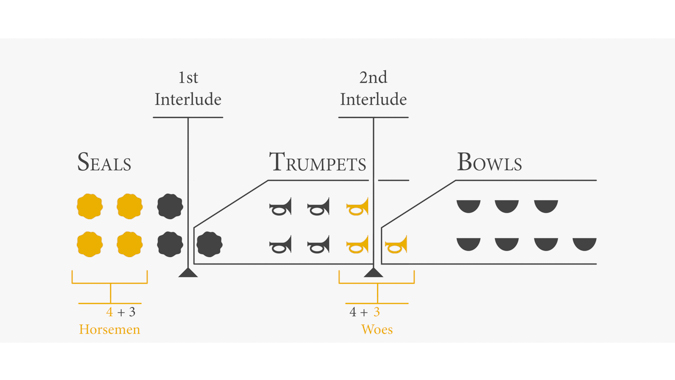
So I put these seal judgments at the beginning of the tribulation—that first half of the tribulation. This is the opening of this scroll as Jesus begins to take the kingdom.
Revelation 6 and Matthew 24
Now, there’s several things about this whole passage that are obviously fascinating. You’ve got these four horsemen at the beginning: the white horse, the red horse, the black horse, this ashen colored horse—these four horsemen of the Apocalypse.
[Tweet “There’s an incredible parallel between Revelation 6 and Matthew chapter 24.”]
But one of the things that we need to see here as we get into this chapter—just as an introductory matter—is there’s an incredible parallel between Revelation 6 and Matthew chapter 24. And I’ve got this chart here for you to look at that you can see.
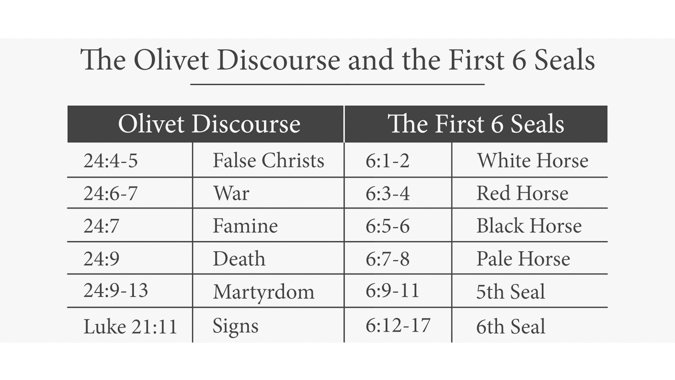
If you go back to Matthew chapter 24, you’ll see that Jesus was asked—you remember, by his disciples—“When will these things be?” that is, when will Jerusalem be destroyed? And then they said, “And what will be the sign of your coming in the end of the age?”
Now think about this. To the disciples whenever Jerusalem was destroyed, that was gonna be the end. So to them, it’s all one big complex of events of, Jerusalem’s gonna be destroyed. It’s gonna be the end of the age. But what they really wanna know is, What are gonna be the signs that are gonna portend your coming to the earth.
And Jesus… you’ll notice Jesus didn’t say to them [when they asked], “What is going to be the sign of your coming in the end of the age?” Jesus didn’t say to them, “Don’t worry about it.” You know, “Don’t worry about signs. Just live for me until I come.” Jesus gives a long litany of signs that will portend his second coming.
[Tweet “Jesus didn’t say to them, “Don’t worry about it.””]
But remember, what is the first thing Jesus says there? Let me turn back there to Matthew chapter 24. Remember, this is just a couple of days before Jesus dies on the cross there on the Mount of Olives where Jesus will return at his second coming according to Zachariah 14. And he gives this last great eschatological discourse. They ask him the question and in verse 4 Jesus answered and said to them, “See to it that no one misleads you. For many will come in my name saying ‘I am the Christ’ and will mislead many.’”So the first thing that’s gonna happen, Jesus says, is a wave of false messiahs (false christs).
The White Horse
Well, look back in Revelation 6—if you just wanna turn back there—he says in 6:1, I saw when the Lamb broke one of the seven seals, and I heard one of the four living creatures saying with a voice of thunder saying, “Come.” And I looked and behold a white horse, and he who sat on it had a bow; and a crown was given to him, and he went out conquering and to conquer.
Three Views of the White Horse
Now some will say, “Well, this is a picture of Jesus because in Revelation 19, Jesus is the one who rides out on white horse. So this is a picture of Jesus.” Or some will say, “This is the preaching of the gospel,” or things like that.
The problem is, remember, these are judgments. And it would be odd for Jesus here to be the contents of one of these seals and to be the one who’s opening the seals. Right? So making this Jesus is odd, especially when you compare it with Matthew 24 where Jesus said the first sign is there will be false messiahs.
So the one riding on a white horse here is a counterfeit of the one who comes in Revelation 19. He is the ultimate false messiah. This coming world ruler—the Antichrist or the beast—will be described further in Revelation chapter 13.
And notice here, he has a bow and a crown, but it’s been often pointed out, he has a bow but no arrows. So it may be, when it says, “He goes forth conquering and to conquer,” this is the conquest—we might say—of cold war. It’s not hot war. He comes and conquers the world by diplomacy because the next rider is the rider on the red horse. And it says he comes and takes peace from the earth. Well, you can only take peace from the earth if there was peace on the earth. So I take it, this first rider being some kind of peace. But again, notice the parallel: false messiahs, rider on a white horse.
The Red Horse
Then notice the next thing Jesus says in Matthew 24:6. You will be hearing of wars and rumors of wars. See to it that you are not frightened, for those things must take place, but that is not yet the end. Nation will rise against nation, and kingdom against kingdom, various places famines and earthquakes. Notice, the rider on the red horse is warfare. Jesus said, “Look, the next things that’s gonna happen is there’s gonna be war: nation against nation, kingdom against kingdom. You have this one coming riding a red horse—the Greek word there is ”pyrros“ (fiery red, the color of blood). And literally it’s, ”He comes and takes the peace from the earth. So there’s gonna be an outbreak of warfare.
The Black Horse
Then notice, the next thing that’s mentioned here by Jesus in Matthew 24 verse 7: “and in various places there will be famines.” What’s the next rider on the next horse—the black horse. When he broke the third seal, I heard the third living creature saying, “Come!” I looked, and behold a black horse, and he who sat upon it had a pair of scales in his hand. And I heard as it were a voice in the center of the four living creatures, saying, “A quart of wheat for a denarius.” Now a quart of wheat is about what it took a person to live for one day—food for a day for a person. And wheat was the more expensive food. So a denarius was what an average worker made working for a day. So you could buy enough of good kind of food for one person to eat for a day. But it says you could get three quarts of barley for a denarius. So you could get enough cheap food—barley was the food that was given to animals. You could get—I guess we’d put it today, maybe beans and macaroni or something like that—enough for three people. But what this pictures, I think, is hyperinflation, where it’s gonna take all that a person has just to be able to buy enough food to eat for a day.
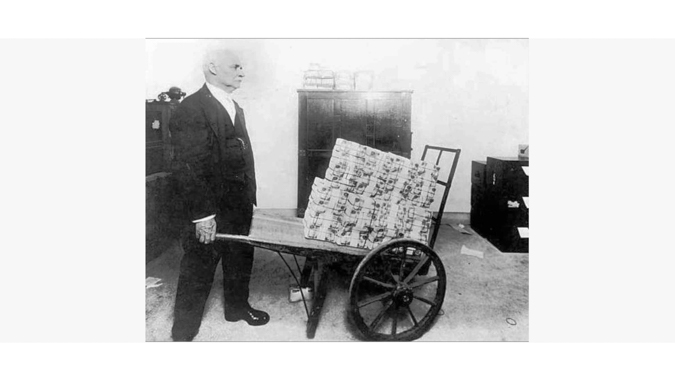
It’s like in Weimar Germany back in the 20s that paved the way for Adolf Hitler. It was stated back then that someone would take a wheelbarrow of money, you know, to buy some food; and they’d have to go get another wheelbarrow full of money to bring with them. When they got back the money was there, but somebody stole the wheelbarrow. The wheelbarrow was worth more than the money was.
[Tweet “Hyperinflation – The wheelbarrow was worth more than the money was.”]
And I think that it’s this kind of future economic collapse in the tribulation of runaway hyperinflation that—just like in Weimar Germany prepared the way for the rise of Hitler, a mad man—that’s gonna prepare the way for the coming of the Antichrist. People are gonna be looking for somebody to solve the problems of the world.
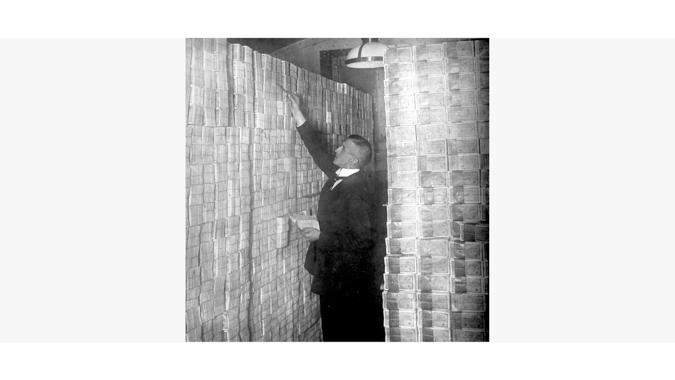
And then notice, the fourth seal is death. There’s famines and there’s gonna be earthquakes and all these various things happening. It says, “These are merely the beginning of birth pangs.” And so there’s gonna be death that’s gonna come. And notice in verse 9: “they’ll deliver you to tribulation and kill you and you’ll be hated by all nations on account of me.” When you go over to Revelation chapter 6 and the fourth seal is opened. And he says, “He broke the fourth seal. I heard the voice of the fourth living creature saying, ‘Come.’ And I looked and beheld an ashen horse. The word there in Greek is ”chloros.” It’s kind of a pale green color. It’s basically the color of a decomposing corpse. I mean, it’s a gross color: the pale rider. And notice, he who sat on it had the name Death, and Hades was following after him. It was like this ashen colored horse. Death is riding on the horse. And it’s like Death is going out and killing people, and Hades is walking right behind him, just taking them right down into Hades as they die. It’s a graphic picture here. And authority was given to them over a fourth of the earth to kill with sword, famine and with pestilence, and by the wild beasts of the earth. So this pale horse…
Now it’s interesting here, he says, “Authority was given to them.” Did you notice as we read through here how many times it says that. It says back up in chapter 6 in verse 2, “The one who sat on it had a bow and a crown was given to him.” And down in verse 4, “And it was given to him to take peace from the earth.” All through this section we see that God is the initiator of these things. God is the one who is having to give them the right to do these things. Because the Lamb is opening these seals. These judgments are coming from God. Now, human beings may be involved in them—certainly in the warfare. Human beings are involved in the warfare, and the killing and the famine will be a result of the warfare. But we don’t wanna loose sight of the fact that God is the initiator in these things.
And there’s gonna be false messiah. There’s gonna be this war. War is gonna give way to terrible famine. We could call that section, really there, the hunger games, if you want to. I mean, it’s gonna be a time of terrible deprivation.
The Pale Horse
And then this fourth horse, Death, comes forth. A fourth of the earth is killed. Think about that. A fourth of the people in the world living at that time are gonna die just in the fourth seal. They die with the sword, with famine, with pestilence. Now we know what that is. The sword is war. Famine is what happened in the third seal. Pestilence is plagues. But then it says, “And by the wild beasts of the earth.” Now what does that mean?
[Tweet “A fourth of the people in the world living at that time are gonna die just in the fourth seal.”]
Three Views about the Wild Beasts
Well, you know some have said, “Well animals are gonna go crazy. You know in the tribulation period. Going around killing people and going wild.”Obviously that could be.
Others would say that the wild beasts of the earth here refers to all the diseases that comes from animals. Think about that. Ebola comes from animals. The AIDS virus came from animals. Bird flu and all these different things… Some people think that could be what it is. You know, the bubonic plague came from rats.
My view though is the word “beasts” here (wild beats) is the word “therion.” It’s used thirty-eight times in Revelation. All the other times it’s used, it refers to the beast, (that final great world ruler) or his henchman (the second beast). So I take it this refers to the military, political rulers on the earth during this coming time. Anyway, you could take different ideas on that, but that’s the view that I have, or the understanding of this passage.
[Tweet “Matthew 24 has often been called the mini Apocalypse. It’s kinda the Readers Digest version…”]
But you can see how this flows with Matthew chapter 24 with the beginning of birth pangs. So Matthew 24 has often been called the mini Apocalypse. It’s kinda the Readers Digest version of the book of Revelation. And you see how it tracks here with this, which tells us, where ever you put Matthew 24, you have to put Revelation 6. They’re parallel. That’s why preterists believe Matthew 24 is about A.D. 70. And they think that Revelation 6 is about A.D. 70. But you’ll find some people that will interpret Matthew 24 as talking about A.D 70, and then take Revelation 6 as being future. But you gotta put them in the same place because of the similarity, I think, between these two.
The Fifth Seal
You go on to the fifth seal here is martyrs: those who are gonna be slain on the earth because of their testimony. Now this is something that always bothered me: how is believers being slain a judgment upon the world, cause remember, these are judgments on the earth. Two things I’ve thought of in that light. One of them could be, as these believers are slain by the evil people in the world during the tribulation, it’s gonna heap up even more judgment for them. And another possibility is, by killing these believers they’re removing the salt and the light from this world. That is gonna even cause more judgment to be upon the face of the earth. There’s gonna be martyrdom. People killed during this time.
The Sixth Seal
And then the sixth seal is opened. He says, “And I looked and he broke the sixth seal and there was a great earth quake and the sun became black as sackcloth made of hair, and the whole moon became like blood. The stars of the sky fell.” I mean this is global cosmic cataclysm that’s taking place with this seal judgment here that’s coming.
Timing of the Rapture
Now one of the issues I wanna deal with here just briefly—I don’t wanna go into it in too much detail—but this brings up the whole subject of the rapture of the church—because… I wanted to mention this that all people believe, all Christians believe— fundamental Christians, evangelical Christians—that we’re (the church of Jesus Christ) gonna be exempt from wrath (from God’s wrath). The question is, when does the wrath start and how are we gonna be preserved through the wrath?
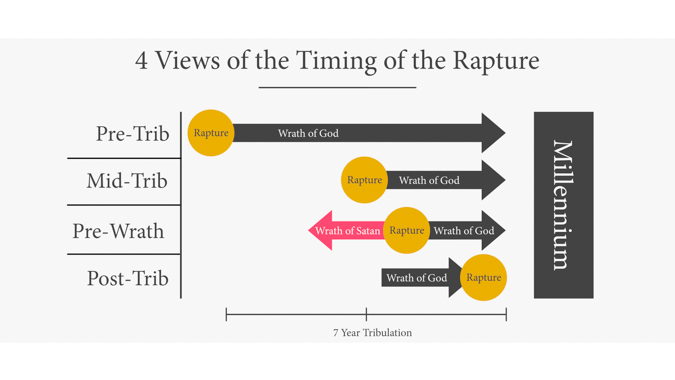
Pre-Trib
The pre-trib view says the whole seven-year tribulation is wrath, and God’s gonna preserve us by taking us out of here.
Mid-Trib
The mid-tribbers say, “No, only the last half is God’s wrath. And so at the mid-point God’s gonna take us out of here.
Pre-Wrath
The pre-wrath view says, “No only the last fourth or so is wrath. So we’re gonna be taken out at that point.
Post-Trib
And the post-tribbers say, “The wrath is only at the very end, and God’s gonna preserve us though the whole period. And we’re gonna go up and meet Jesus as he’s coming down and do a u-turn—I call it the yo-yo view of the rapture. We’re gonna go up and meet Jesus and do a u-turn and come back down.
So everybody agrees: we’re exempt from God’s wrath. The question is, when does the wrath start, and how does God exempt us from it?
Those who hold to what’s called the pre-wrath rapture, they say, “The wrath starts right here in the sixth seal. So the rapture is between the sixth and seventh seal judgment. That’s where they place it.
My view is, as a pre-tribber, I think the whole seven year tribulation’s wrath because again, you go back and look at, who is the one who’s opening these seals? It’s the Lamb. He’s the one it’s given to him to have a crown. It was given to him to take the peace from the earth. He’s the one, I believe, who’s in control of this and the initiator of these things. Certainly people are used as instruments in these judgments. And I would agree, the judgments get worse as you go along. The trumpets are worse than the seals. The bowls are worse than the trumpets. But I believe that all of these seals are judgment. They are all the judgment and the wrath of God. And believing that then, I believe that the church will be taken out before that wrath begins to be poured out. Again, going back to chapter 3 verse 10. He’s gonna keep us from the hour of testing. That hour that’s coming upon the earth to test those who dwell on the earth.
So it’s another issue here kinda about when does the wrath really start. Certainly it’s clear, when you get to the sixth seal, that the wrath has started cause it mentions it clearly here in this passage.
But again the Lamb opening the seals, the repeated phrase “it was given to him,” shows these things are happening as a result, I think, here of the divine initiative.
Conclusion
Notice how this chapter ends. It’s a sobering chapter. Verse 14, “The sky was split apart like a scroll when it’s rolled up. Every mountain and island will move out of their places. Kings of the earth, the great men, the commanders, the rich, the strong, every slave and free man, hid themselves in the caves and among the rocks of the mountains. And they said to the mountains and to the rocks, ‘Fall on us and hide us from the presence of him who sits on the throne and from the wrath of the Lamb!’” You don’t think about a lamb having wrath very often. Do you? A nice little, soft little, wonderful lamb… What this shows me is, they know this is from God. And they’re calling out to the rocks to fall on them and to hide them from him who sits on the throne and from the Lamb.
Notice verse 17. For the great day of their wrath has come, and who is able to stand? The point there is, nobody! Apart from God’s grace and God’s power, nobody is gonna be able to stand.
I like what one man I read one time said. He made this beautiful statement. He says, the men here, the rulers, the kings of the earth, they cry out upon rocks and upon nature to come and to save them. But he says, There’s no deliverance. But he said, there is a rock that can save us that we can call out to. And of course that’s the Lord Jesus Christ, that lamb, the Rock of Ages. So there’s a Rock that we can cry out to in our time of distress or trouble. He’ll come to us and deliver us.
[Tweet “There is a rock that can save us that we can call out to. And of course that’s the Lord Jesus Christ.”]
Chapter 6 ends with these words, “The great day of their wrath is come. Who is able to stand?” Well, chapter 7 is gonna answer that question. You don’t have to go long to find the answer. There’s a group of people who are gonna stand during this time of wrath that comes on the earth: chapter 7’s a hundred and forty-four thousand and there’s a great multitude that are given to us there.
Chapter 7 is gonna be the first of these interludes because we’ve gotten to sixth seal. Now we haven’t gotten to the seventh one yet. The seventh seal’s not gonna be till chapter 8. So we’re gonna have the first one of our little fill-ins or intermissions or interludes in chapter 7. So we’ll pick up there next time and we’ll see who it is that is able to stand whenever this time of judgment is gonna be unleashed upon the world.


